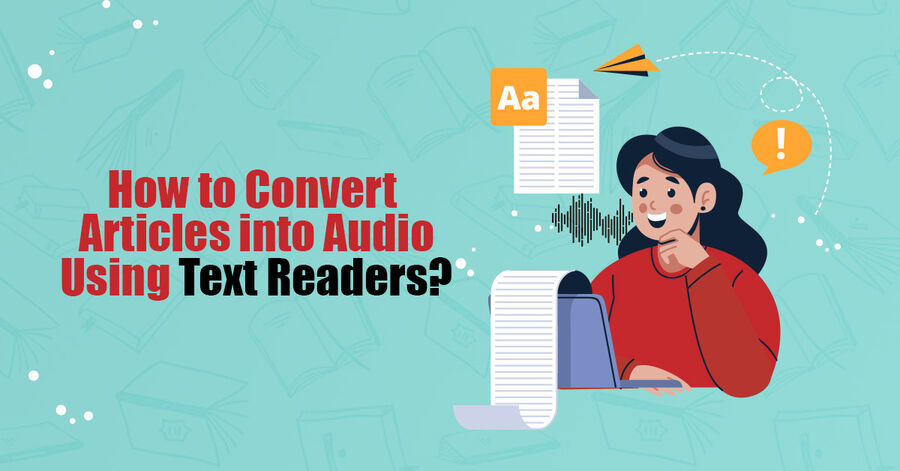Turning articles into audio using text readers is a smart way to consume content. It’s like having someone read the article to you. This method is great for people who are always on the move or prefer listening over reading.
In this article, we will discuss how text-to-speech technology works and its benefits. We’ll explore different text reader tools and tips on choosing the best one for your needs.
What is a Text Reader?
A text reader is a tool that changes written words into speech. It’s like having someone read an article to you. This is helpful for people who prefer listening over reading.
You can turn blogs, news, or any written stuff into audio. It’s easy to use and great for multitasking, like listening while you do other things. Text readers are super useful for making audio versions of articles.
If you have a blog or a website, you can use a text reader to offer an audio option. This way, your visitors can listen to your content if they can’t or don’t want to read. It’s a great way to reach more people and make your content more accessible.
Why Use Text Reader?
Using text readers to convert articles into audio is super useful. They turn written words into speech, making it easy to listen to articles instead of reading. This is great for people who are busy or prefer listening over reading.

Text readers can also help those with reading difficulties or visual impairments. They make information more accessible. Plus, you can listen to articles while doing other stuff, like driving or cooking.
This technology is also great for learning. Listening to articles can improve language skills and comprehension. It’s a handy tool for everyone, making information easier to access and understand.
Advantages Of Using Text Reader
Accessibility
Text readers help people who have trouble seeing or reading. They can listen to words instead of struggling to read them. This is useful for those with visual impairments or reading disabilities.
It makes getting information easier and more inclusive. Everyone, regardless of their ability to read, gets to access and enjoy content.
Convenience
Text readers let you listen to books or articles while doing other stuff. This is great for busy times. Like when you’re driving or cooking, you can still learn or enjoy a story.
This is a big plus for text readers. They help you do two things at once. So, you save time and still get to listen to interesting content.
Learning
Text readers make learning easy and fun. They read out loud, which helps you understand better. This is great for people who find reading tough.
They also save time. You can listen while doing other things, like cooking or traveling. It’s like having a book read to you.
Lastly, text readers help with pronunciation and language learning. Hearing words spoken correctly improve your speaking skills. It helps to learn new languages.
Efficiency
A text reader boosts efficiency. It reads out loud, saving you time. You don’t strain your eyes reading.
It’s great for multitasking. You can listen while doing other tasks. This increases productivity.
It helps everyone, especially those who find reading hard. They can understand better when listening. This makes learning easier for them.
Portability
Portability is a big plus for text readers. It means you can use them on different devices, like phones, tablets, or computers. This is handy because you can read stuff on the go, wherever you are.
You’re not stuck in one place. So, with text readers, you have the freedom to access your reading material anytime, anywhere. This makes life easier, especially if you’re always moving around.
Steps to Convert Articles into Audio Using Text Readers
Converting articles into audio using On4t Text to Speech is a straightforward process. Here’s a step-by-step guide:
Step 1. Open On4t Text to Speech: First, go to the On4t Text to Speech website.
Step 2. Select or Upload Your Text: You’ll see an option to either type in your text or upload a document containing the text. If you have an article ready, you can just upload the file.
Step 3. Choose Language and Voice: On4t typically offers a variety of languages and voices. Pick the one that suits your needs. Some text-to-speech tools allow you to choose between different accents or even the gender of the voice.
Step 4. Adjust Settings: You might have options to adjust the speed, pitch, or tone of the reading. Play around with these settings to get the audio output that sounds right to you.
Step 5. Convert to Audio: Once everything is set up, click the button to convert the text into speech. This process might take a few moments depending on the length of your article.
Step 6. Listen to the Preview: After the conversion, you usually get to listen to a preview. This step is important to ensure that everything sounds as expected.
Step 7. Download the Audio File: If you’re happy with the result, you can download the audio file. The format is typically MP3 or WAV, which is convenient for most users.
That’s about it. Pretty simple, right? This can be a great way to turn your written content into something more accessible and versatile.
Conclusion
Turning articles into audio with text readers makes information more accessible. It’s helpful for those who prefer listening or have trouble reading.
Plus, it’s convenient, allowing people to learn while doing other things. This tech is a game-changer, making knowledge easy to get for everyone.